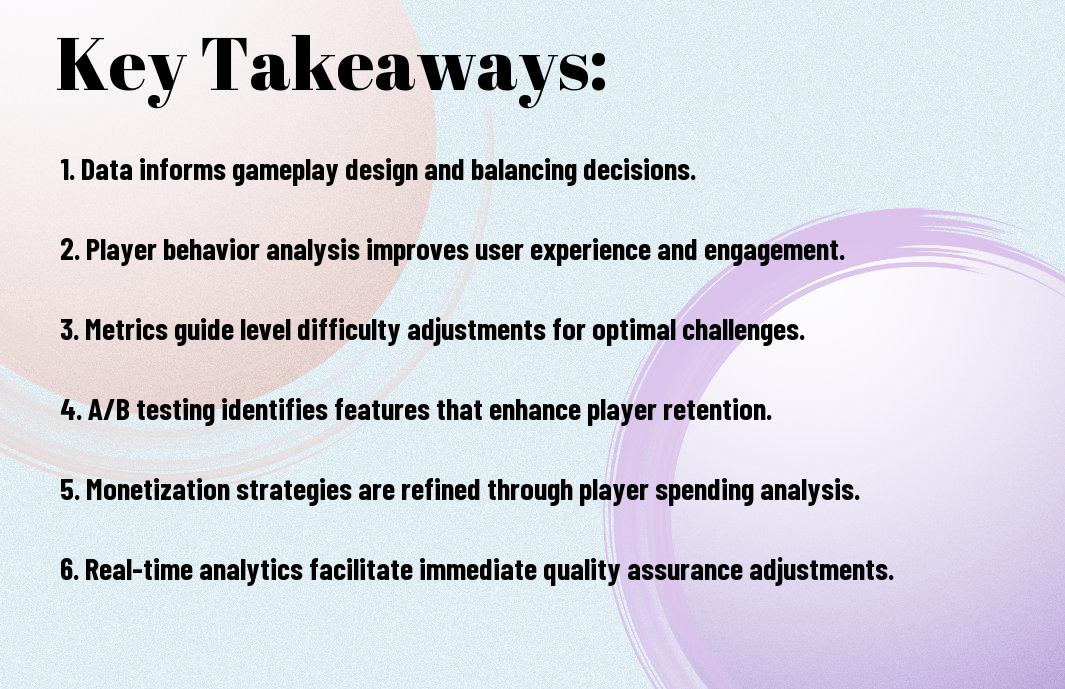As you examine your favorite video game, you may wonder what goes into creating an immersive experience. You’ll be surprised to know that data analytics plays a significant role in enhancing gameplay. Your gaming behavior, from character selection to level completion, is tracked and analyzed to identify trends and patterns. This information helps developers refine their games, making them more engaging and enjoyable for you, the player. By leveraging data analytics, developers can optimize gameplay, fix issues, and create a better overall experience tailored to your preferences.
Key Takeaways:
- Developers utilize data analytics to gain insights into player behavior, allowing them to identify trends, patterns, and areas for improvement in their video games.
- Data analytics helps developers to optimize game performance, reducing latency and improving the overall gaming experience for players.
- By analyzing player data, developers can create more personalized experiences, tailoring the game to individual player preferences and behaviors.
- Data analytics informs design decisions, enabling developers to create more engaging and effective game mechanics, levels, and user interfaces.
- Developers use data analytics to identify and fix issues, such as bugs and glitches, more efficiently, reducing downtime and improving player satisfaction.
- Data analytics provides valuable insights into player retention and monetization, helping developers to develop effective strategies to keep players engaged and drive revenue.
- The use of data analytics in game development enables developers to measure the success of their games and make data-driven decisions to improve future game development projects.
Data Collection in Gaming
While developing a game, you collect data to understand your players’ behavior and preferences. This data helps you identify areas for improvement and optimize your game for better engagement.
Player Behavior Tracking
Any analysis of player behavior starts with tracking their actions, such as gameplay time, progress, and interactions. You can use this data to create a more personalized experience for your players.
Performance Metrics
Against the backdrop of intense competition, you need to monitor performance metrics like frame rate, load times, and crash rates to ensure a smooth gaming experience.
Due to the complexity of modern games, you will need to research deeper into performance metrics to identify bottlenecks and areas for optimization, allowing you to fine-tune your game and provide your players with the best possible experience.

Real-time Analytics Systems
If you’re looking to enhance your video games, real-time analytics systems can provide valuable insights into player behavior, allowing you to make data-driven decisions to improve your game.
In-game Decision Engines
The key to creating an engaging gaming experience is to use data analytics to inform in-game decision engines, enabling you to personalize your game and increase player satisfaction, as you tailor the experience to your players’ preferences.
Dynamic Difficulty Adjustment
Against the backdrop of evolving player behavior, dynamic difficulty adjustment enables you to adjust the game’s difficulty level in real-time, ensuring that your players remain engaged and challenged, without becoming frustrated or bored, as you strive to create an optimal experience.
Even as you implement dynamic difficulty adjustment, you’ll find that it has a significant impact on player retention, as you’re able to strike a balance between challenge and reward, keeping your players motivated and invested in your game, and allowing you to build a loyal community of players who appreciate your attention to detail and commitment to their experience.
Player Experience Optimization
After collecting data, you can identify areas to improve your game, enhancing the overall player experience and increasing engagement.
Engagement Metrics
Experiencing a well-designed game is key to keeping players interested, and you can track metrics such as playtime and interaction to understand what works best for your audience.
Retention Analysis
Among the most important aspects of game development, analyzing player retention helps you understand why players leave or stay, allowing you to make informed decisions to improve your game.
Even with a solid understanding of retention analysis, you will still need to continually monitor and adjust your strategies, as player behavior and preferences can change over time, and you must be prepared to adapt your game to meet these evolving needs, ensuring that your players remain engaged and interested in your game.

Monetization Analytics
Many game developers rely on data analytics to optimize their monetization strategies, increasing revenue and enhancing the overall player experience. You can use data to identify trends, track player behavior, and make informed decisions about in-game purchases and virtual currency.
Purchase Pattern Analysis
Assessment of player spending habits helps you understand what drives purchases and identify opportunities to boost sales. You can analyze data on purchase frequency, average transaction value, and popular items to inform your monetization strategy.
Virtual Economy Balance
Assessment of your game’s virtual economy is vital to ensuring a balanced and engaging experience. You can use data to monitor the flow of virtual currency, identify areas of imbalance, and make adjustments to keep players engaged.
A key aspect of virtual economy balance is maintaining a fair and rewarding system. As you analyze your game’s economy, you’ll want to consider factors such as currency distribution, item pricing, and player progression. By making data-driven decisions, you can create a virtual economy that keeps players invested in your game, encouraging them to continue playing and spending.
Gameplay Refinement
All aspects of gameplay can be refined using data analytics, allowing you to create a more engaging and immersive experience for your players. By analyzing player behavior, you can identify areas that need improvement and make data-driven decisions to enhance your game.
Level Design Analytics
Refining your level design is crucial to keeping players engaged, and with data analytics, you can optimize your levels to improve player progression and overall experience, helping you to identify which levels are most challenging for your players.
Combat System Optimization
With combat system optimization, you can analyze player interactions and identify areas where your combat system can be improved, enabling you to create a more balanced and enjoyable experience for your players.
To optimize your combat system, you will need to analyze data on player behavior, such as win/loss ratios, player deaths, and combat strategies, and use this information to make adjustments to your game’s mechanics, such as tweaking enemy difficulty or adjusting player abilities, allowing you to create a more engaging and challenging experience for your players.
Social Interaction Data
Despite the complexity of social interactions in video games, you can leverage data analytics to gain valuable insights into player behavior. By analyzing social interaction data, you can identify trends and patterns that inform game development and improvement.
Multiplayer Behavior Analysis
Sociably, you can examine how players interact with each other in multiplayer modes, including communication patterns, teamwork, and conflict resolution, to create a more engaging experience.
Community Patterns
About the community, you can analyze data to understand how players form groups, share information, and collaborate to achieve common goals, which helps you design more effective community-building features.
Consequently, as you examine deeper into community patterns, you will discover that understanding player behavior and social interactions can help you create a more immersive and engaging experience, allowing you to tailor your game to meet the needs and preferences of your players, and ultimately, driving player retention and loyalty.
To wrap up
Summing up, you now understand how developers use data analytics to enhance video games, making your gaming experience more engaging. As you explore the world of gaming analytics, you can probe deeper into Gaming Analytics: Leveling Up With Data-Driven Insights to discover how your favorite games leverage data to improve your overall experience, allowing you to appreciate the complexity behind your favorite games.
FAQ
Q: What role do data analytics play in the development of video games, and how do developers utilize them to enhance gameplay?
A: Data analytics play a significant role in the development of video games, as they provide developers with valuable insights into player behavior, preferences, and pain points. By analyzing data on player interactions, developers can identify areas of improvement, optimize game mechanics, and create a more engaging and immersive experience. For instance, analytics can help developers track player progression, identify bottlenecks, and adjust difficulty levels to ensure a smooth and enjoyable experience. Additionally, data analytics can inform the development of new features, modes, and content, allowing developers to create a more dynamic and responsive game world.
Q: How do developers collect and analyze data from video games, and what tools do they use to gain insights into player behavior?
A: Developers collect data from video games through a variety of methods, including in-game telemetry, player surveys, and online forums. They use specialized tools, such as Google Analytics, Tableau, or Splunk, to analyze the collected data and gain insights into player behavior. These tools enable developers to track key performance indicators (KPIs) like player engagement, retention, and monetization, as well as identify trends and patterns in player behavior. Furthermore, developers can use data visualization techniques, such as heat maps and funnel analysis, to better understand how players interact with the game and identify areas for improvement.
Q: Can data analytics help developers identify and fix issues with video games, and if so, how do they use data to inform their decision-making process?
A: Yes, data analytics can help developers identify and fix issues with video games. By analyzing data on player behavior and game performance, developers can quickly identify areas where players are experiencing frustration or difficulty. For example, if a large number of players are getting stuck on a particular level or are experiencing technical issues, developers can use data analytics to pinpoint the problem and make targeted fixes. Additionally, data analytics can inform the decision-making process by providing developers with a data-driven understanding of the impact of different design choices and updates on player behavior and game performance. This enables developers to make informed decisions about how to allocate resources, prioritize bug fixes, and optimize the overall gaming experience.



